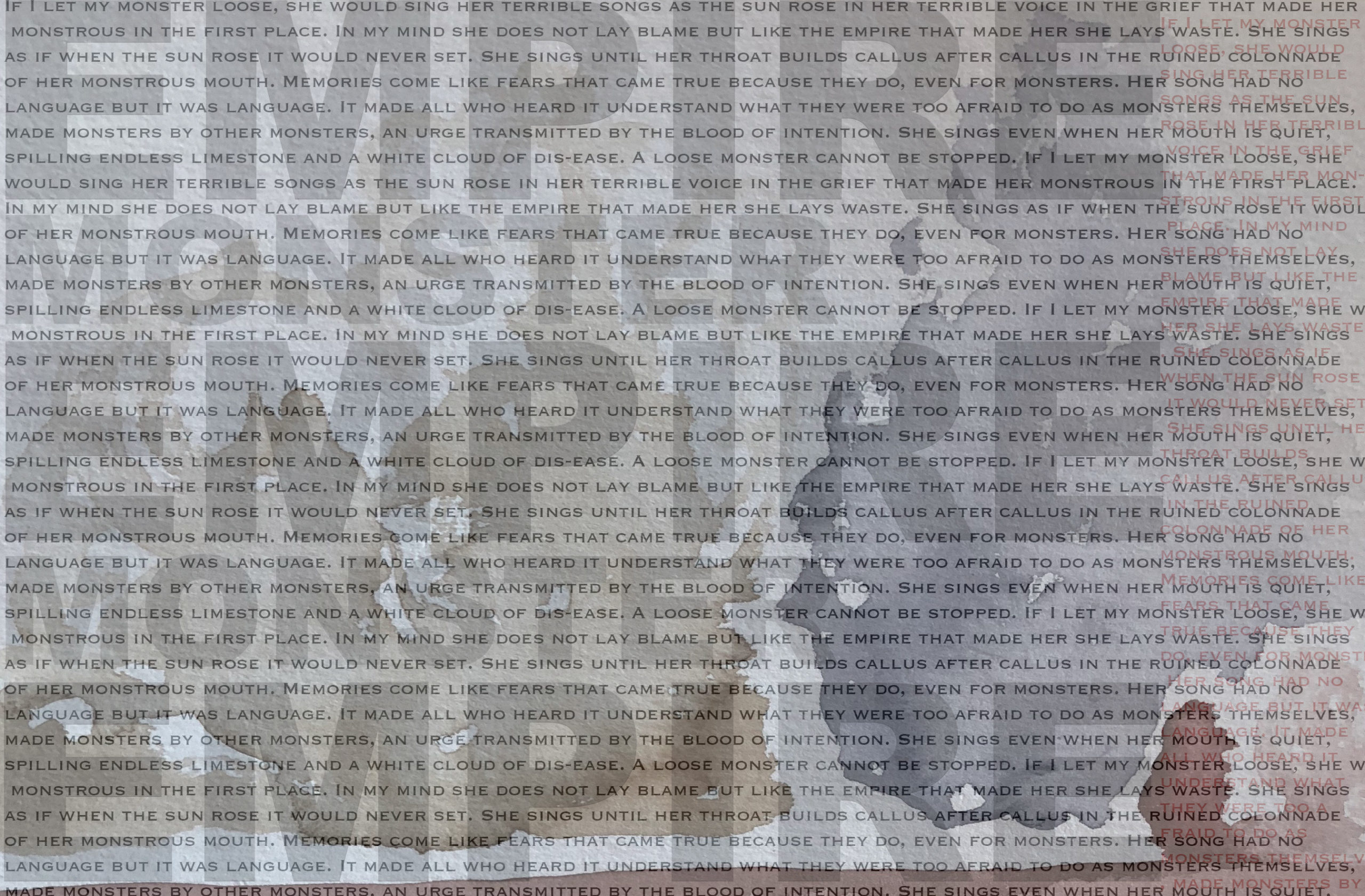
Black women are supposed to have strong backbones but my Black back is jacked.
Before he cracked my neck, the chiropractor told me I had an Atlas tilt at the top of my cervical spine. The weight of the world on my shoulders. It was unclear to me whether the Atlas could be manipulated back into place on its axis.
Ori mi pe, the classic Adire cloth indigo design, literally translates as, “my head is correct.” In Yoruba belief the head is the seat of personal destiny. Therefore, ori mi pe means, “I will have a good destiny.” But my head is not correct. The junction of my skull and spine is off, the nerve center misfiring in that cathedral of delicate bones. I wonder what this means about my destiny.
When did I start feeling the pain? I think it was when our republic elected the demagogue. I remember the presidential debate. She, in her white pantsuit. He, pacing behind her like a menacing ape. The familiarity of that dance. He’s going to hit her, I thought. I clenched my shoulders. I have not been able to unclench them since.
The election coincided with a great heartbreak of which I dare not speak, even with a facsimile of anonymity. The heartache would fall to others, like a chain of dominoes, wrecking multiple lives. I would rather carry the grief alone. It is enough to say that the external calamity, which was political, coincided with the internal calamity, which was
personal. My body, my country: broken.
Cervix refers to the neck, or any neck-like part, especially the constricted lower end of the uterus.
When he was deep inside me, my lover, my predator, claimed that he could feel my cervix.
“Do you feel guilty?” asked the primary care physician before referring me to a psychotherapist. I was already seeing a therapist, who’d insisted on blood work and recommended bringing my husband to vouch for the truth of my pain since doctors, as a general rule, disbelieve women. My husband was busy. I was busier than him by far, and on top of that, I was sick. The blood test could not explain why my hair was falling
out. Thyroid, endocrine system, hormones: normal range. And yet, I could barely get out of bed. I wasn’t free to stay in bed. Duty called. My children needed food and feeding, washing, cuddles, stories, protection from the incessant evil messaging of white folks, and lotion on their ashy knees. My students needed feedback, mentoring, encouragement, recommendation letters, and advice on handling the sexual advances of their male professors. My health insurance needed explanations for all the office visits. Either my spine was the sum of my moods or a vertical timeline of historical abuse.
The orthopedic surgeon barely glanced at the x-rays before accusing me of being a boring patient. “You must have a lot of time on your hands,” he dismissed my symptoms, “to be worrying over nothing.” The pain, he implied, was all in my head. I did not have a lot of time on my hands. I had next to no time to myself, practically none at all. But it felt as though I was suffering whiplash. I am the backbone of my family, I wanted to tell him, how dare you speak to me like that, I am the backbone of my community. I am an educated woman suffering private heartache under a dictatorship.
The symptoms radiating down the nervous system like falling dominoes included tension headache, jaw pain, limited head rotation, stiff neck, shoulder pain, tennis elbow, carpal tunnel syndrome, pelvic asymmetry, asthma, protrusion of disks, chronically cold hands and feet, low blood pressure, low self-confidence, chronic diarrhea, despair, and fatigue. Worst of all, I could no longer hold up my head.
The dentist said I was like the princess and the pea. My teeth conveyed no rationale for the throbbing pain in my jaw. He accused my mouth of perfect teeth but nevertheless referred me to an oral surgeon with the manner of a Nazi. I told him I couldn’t sleep. You’re like the princess and the pea, the surgeon said, with the same disdain as the dentist. The two of them were in a private club, they shared a language, a philosophy predicated on the put-down. Neither man would prescribe painkillers. In spite of my straight white teeth, they suspected that I was an addict hustling for opiates, that my mouth was a den of lies.
The pain travelled. While I searched for care, countless women, including my mother, gathered in the cities, and in the capital, and across the globe, wearing pink pussy hats. Meanwhile, my husband asked me to leave our apartment so that he could play violent video games in solitude. “Call of Duty.” He was granted an award for being a genius. When the school complained about the behavior of our son, it was me they called, never him.
I was not alone in my illness, nor alone in being blamed for my illness. We grew fibroids. Nobody knew why more black and brown women were afflicted at a higher rate. Our uterine lining began appearing in unexpected parts of our bodies, including our brains. Endometriosis. Prolapse. They removed the uterus of my friend. They put children in cages at the border. We were angry at the lie of Women’s Lib and Civil Rights, at the failed experiment of our country. We admitted to ourselves that white people could not be redeemed. We were taunted by our president’s tweets. Unsure what to do with our rage, we turned it on ourselves.
Our immune systems attacked us. We grew tumors. “Me, too,” we said. “Me too.” The previous season we’d been saying “Black Lives Matter.” Nobody listened. Nobody knew how to balance our hormones. Probably there was not enough money in it. They theorized it was because we were not bearing enough children. We begged for estrogen
and were refused. Our perception was either extremely distorted or crystal clear. Our cells multiplied, rampantly, into more tumors. They tried to remove the breasts of my friend, who insisted on keeping them for the sake of her sex appeal, for the sake of her self and her love of sex, and somehow I understood her stance was rooted in her being
African. As for the rest of us, unless we were queer, we were having disappointing sex, or torrid self-destructive love affairs, or no sex at all.
When my senior colleague asked me to wear the pair of fancy lace panties he’d brought back from Paris at the next faculty meeting, I could have reported him. Maybe I should have. But I did not trust the system to take him down. Instead I kept the panties, and waited. They were as multicolored as a peacock feather. They were worthy of Josephine Baker. They were the sexiest panties I’ve ever owned. Wearing them was a misdemeanor of survival.
During the hearing of the scoundrel accused of sexual assault nominated to the Supreme Court, I waited at the hospital in radiology for my turn in the MRI machine. CNN played in the waiting room. Everyone present was in pain and disgust with our president. America didn’t listen to the woman. The technician gifted me a pair of earplugs. But it was as loud as a uterus inside that white sarcophagus. The clacking noises sounded nearly human. “Dewey,” repeated the voice, nonsensically. “God.” “Dot.” “Did I?” I was not to move.
This was my second time in an MRI machine. The first was to examine a cystic tumor in my throat, years before. It was blocked anger, unreleased. They cut it out of me and now I wear a scar on my neck that makes me look tough, or victimized, depending on point of view. Back then, I hoped the magnetic field and radio waves generating images of my insides might be rearranging my atoms; that I might come out a different person. Preferably a stronger one. But I did not.
Now, shoved back into the machine, I considered patterns of predation. A cervix. A throat. How much could be forced into those openings. How much shit could be swallowed. I recalled my lover, my predator, once telling me not to move. I would feel more pleasure if I kept still, he said before giving me an STD. “Dewey.” “God.” “Dot.” Some people are triggered by the noise, they’d warned me outside the machine, some people get claustrophobic in there. “Did I?” Push this button if you get scared.
It came as no surprise when I was told that I was among the least qualified of the hundreds of applicants who applied for my position, and that I filled a demographic niche as a Black woman. That I should be grateful. I was the gift of diversity. I was living my ancestors’ wildest dreams. Therefore, I should not behave as a diva.
The midwife who caught my children years before tried to teach me a new technique called havening. She had me trigger the trauma, massage my own face with the tips of my fingers, and, hugging myself, do the same to the tops of my arms, replicating a mother’s touch; to mother myself. I was to repeat this mantra: “I deserve to feel safe.” I wanted it to work but admitted it did not. The trigger is too large, reasoned the midwife, the trigger is patriarchy, and all the babies being born to women in this era will inherit the fight-or-flight response through the umbilical cords of their mothers. Wait and see.
When my colleague became my boss I reminded him of the panties. “Ever since you gave me that gift,” I lied, “I’ve understood I could count on you as a friend.” I asked him for something. I don’t remember what. Probably I asked him for time to myself. Or an office with a window. Whatever it was, I didn’t get it.
The integrative health doctor advised me to quit running. “You’re running with cement blocks on your feet,” she said. “You have next to no bandwidth. You are like a vessel nearly empty of water. You are not strong enough to run.” After mixing these metaphors, she gave me the card of a somatic therapist. I recognized the name on the card as belonging to a man who fucked my friend when she sought his help to get her head correct. I asked to see a woman and stopped training for races.
The female somatic therapist told me it was epigenetics causing my pain. The inherited trauma of my enslaved ancestors, the burdens of my grandmother after they lynched my grandfather, etc…. According to the latest study, these injustices were encoded within me. She handed me a foam sledgehammer and encouraged me to use it to externalize my rage. This exercise embarrassed me but I did not wish to hurt the well-meaning white woman’s feelings. Performing my rage for her by pounding that silly prop against a loveseat from West Elm, I felt enraged.
The burly physiatrist was so aggressively rude to his cowering receptionist that I walked out of his practice before he could look at my body. I presumed that at home he beat his wife. The gold chain nestled in the black chest hair in the V-neck of his scrubs made me sick.
Patterns of predation were getting amplified in the sloppy court of public opinion. The hunt for a cure was growing expensive. The diagnosis was inexact. My freedom of movement, that is, my range of motion was restricted. This much I knew: I could not afford a broken back. Too many people depended upon me.
The osteopath was a good witch, I could tell. Her fingers felt nice at the base of my skull and I did not exactly think her racist when she theorized that so many Black women in America are overweight because inherited trauma has made us warehouse our fat for the lean times. But by the time I left her padded table for the Korean market next to her
practice to buy a pack of frozen black bean buns, my back was hurting again, the weight of it all was too much to bear, her juju was gone.
“You are not symmetrical,” the acupuncturist said. “Your muscles are calcified already. Your spine is no good. Your neck is no good. Your psoas is weak.” He said he could treat the pain, ninety percent of which was in my head. I believed him ninety percent. Two times a week he needled me with insults. I pondered my pain and tried to breathe. That I could not relax or release was my fault, that my muscles were in constant spasm, that my back had become a carapace, a shield, was my fault. The doctor promised, quite arrogantly, to make the pain go away. On his wall hung a cartoon caricature of the doctor next to a frightened-looking porcupine who asks, “How many needles?”
A log of misalignment when the figure in question intrudes upon my thoughts:
as I lay upon the acupuncture table
as I wait for the train
as I bathe with lavender soap
as I fall asleep
as I plank
as I prolong getting out of bed in the morning
as I lay out the children’s school clothes
as I peel the green apples
as I comb my hair before the mirror
as I photograph birds
as I move the wet clothes from the washer to the dryer
as the abuser is confirmed to high office
as I breathe
as I attempt to write the novel
as I wait for the children’s school bus
as I fold the laundry into separate piles
The highest spinal center is located in the medulla oblongata, at the base of the brain just above the place where the neck connects with the skull—the sixth chakra, through which cosmic energy nourishes the body with prana, conscious cosmic energy. I was the only Black woman in the yoga studio where the instructor spoke of chakras as the seven gates of freedom along the astral spine, after asking us to chant om, and I didn’t forget it, that I was the only Black woman, for the entire class, not even in tree pose where I balanced as straight as I could with a misaligned spine.
Death by a million microaggressions. By air pollution. By disillusionment and the disintegration of kinship structures. By ‘The Man.’ By the world of goddamned men. By the weight of my grandmother’s sorrow. By America. Death by the wolf of debt. A slow, inglorious death.
In the bestselling book on mind-body connection and healing back pain without drugs, surgery, or exercise, the author advises spending fifteen minutes every day reminding the brain that there is no structural problem, in a meditative state meant to induce myofascial release. Knowing that repressed anger and anxiety are the triggers, I am
supposed to tell myself my back is fine. And yet,
the structural problem is real.
“Spinal Column” was also published in Gay Mag, and is available to read here.
Image Credits: Dawn Endico
The Ferrante Project: A collective of 16 women writers of color experimenting with freedom, anti-fame, and anonymity. Contributors include: Cathy Linh Che, Angie Cruz, Natalie Díaz, Ru Freeman, Sarah Gambito Cristina García, Jamey Hatley, Dawn Lundy Martin, Ayana Mathis, Vi khi nao, Aimee Nezhukumatathil, Deborah Paredez, Khadijah Queen, Emily Raboteau, Paisley Rekdal, and Lyrae Van Clief- Stefanon.







